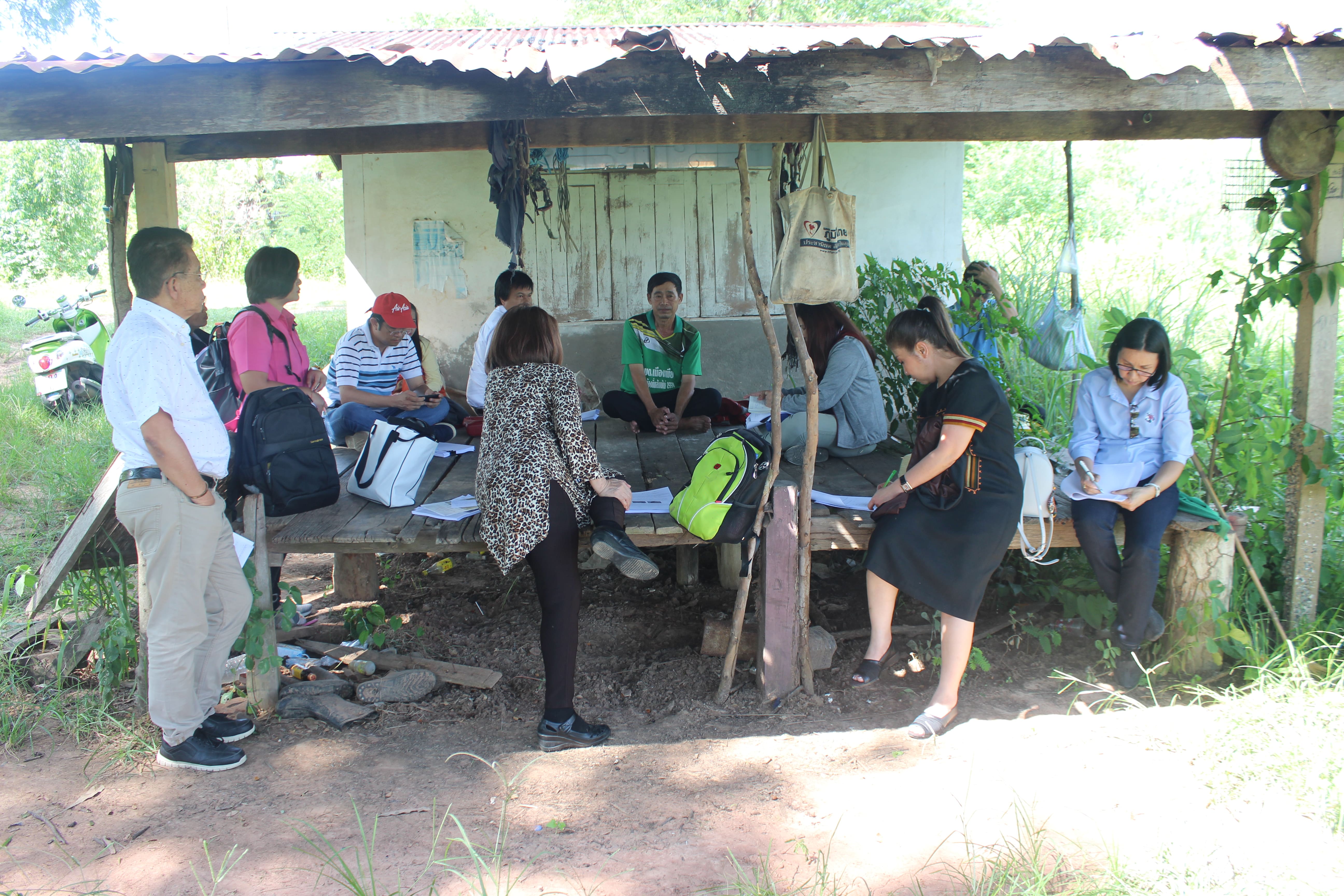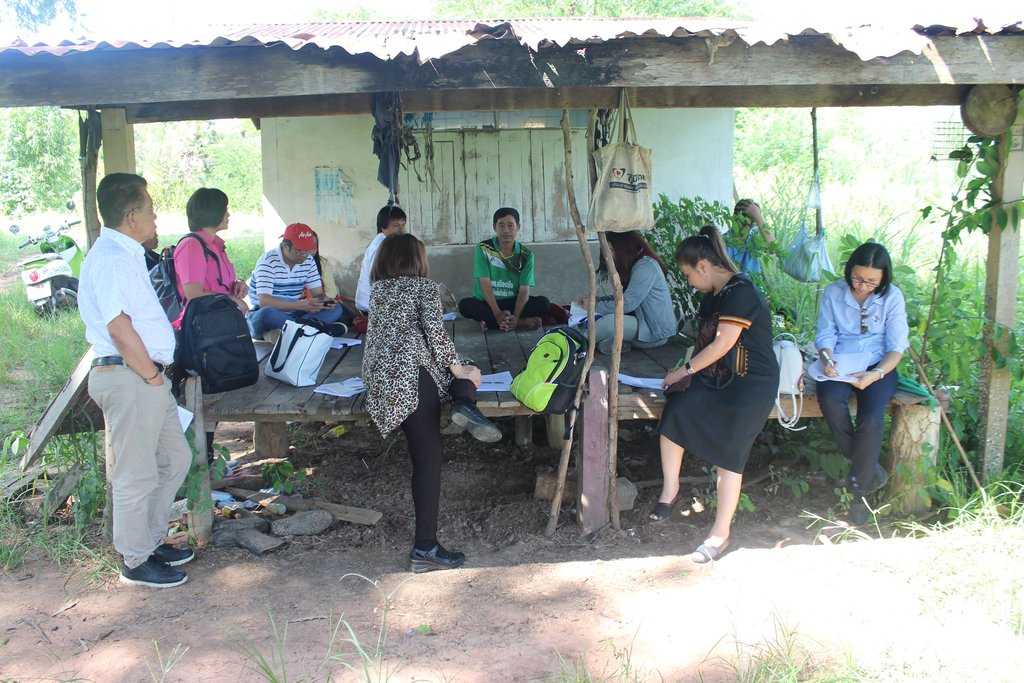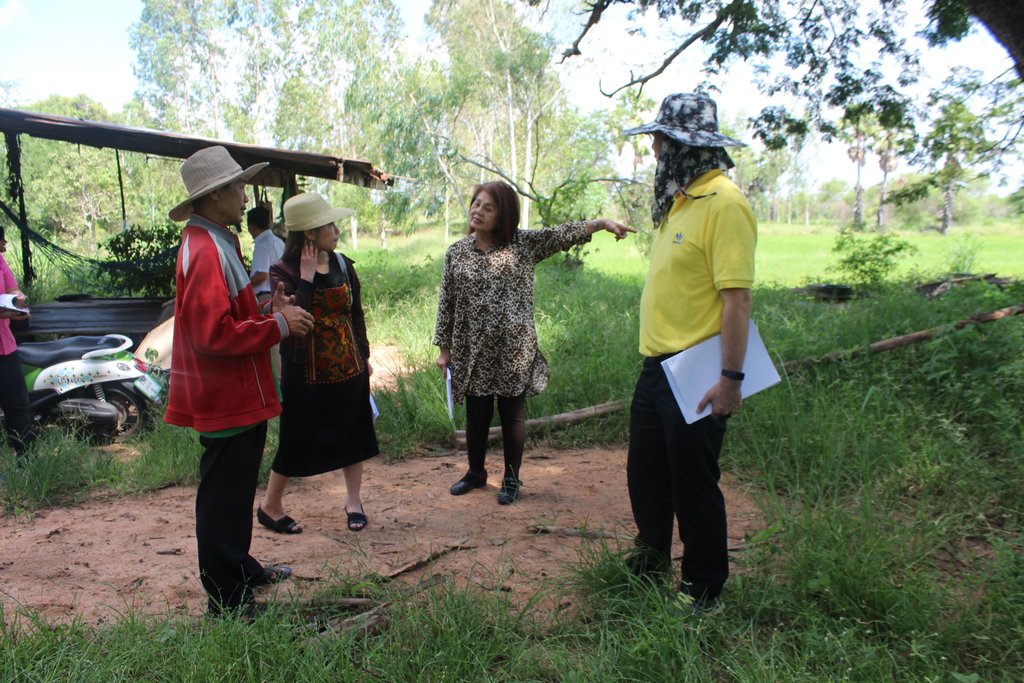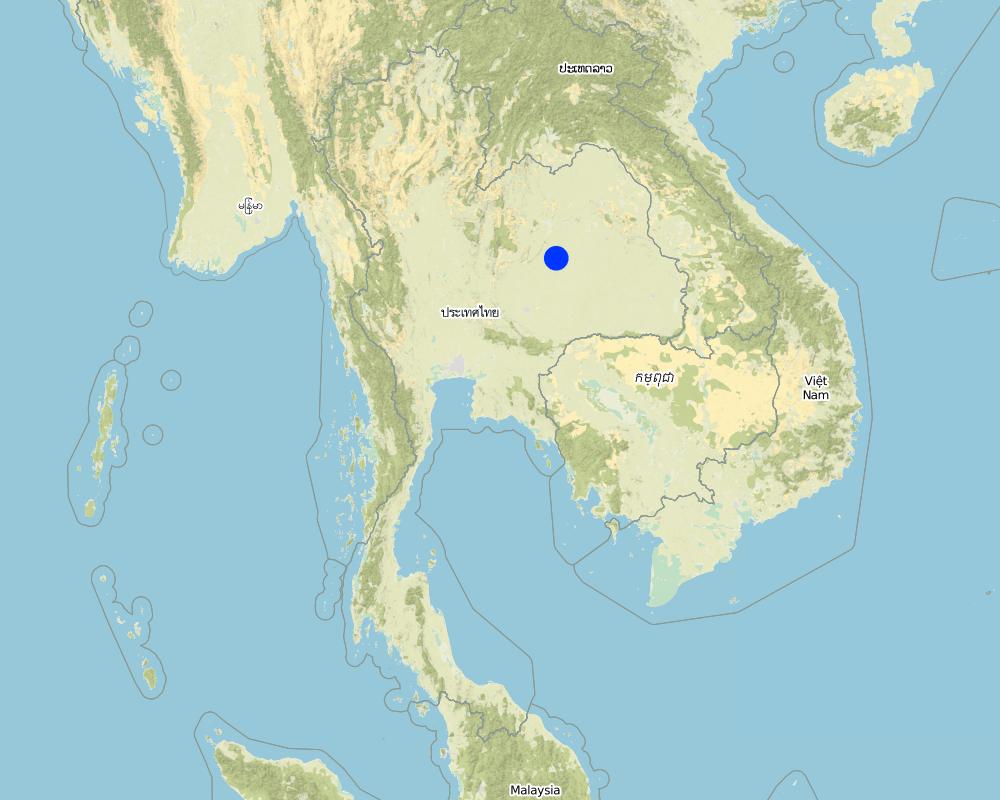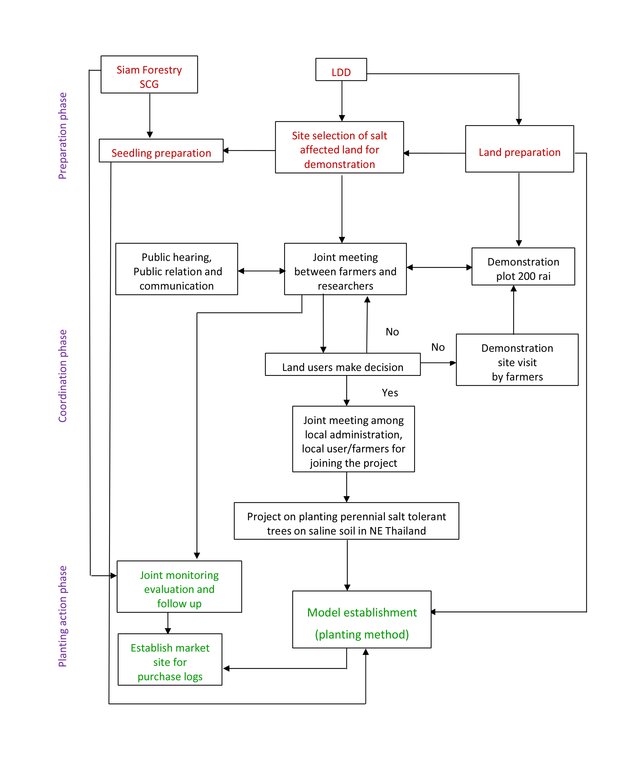Advisory system for planting Eucalyptus camaldulensis on rice bunds in the salt affected areas. [Thailand]
- Creation:
- Update:
- Compiler: Areerat Wangkaew
- Editor: –
- Reviewer: Rima Mekdaschi Studer
approaches_4103 - Thailand
View sections
Expand all Collapse all1. General information
1.2 Contact details of resource persons and institutions involved in the assessment and documentation of the Approach
Key resource person(s)
land user:
Chearnchai Sayan
Ban Muang Pia, Muang Pia Sub-disdrict, Ban Pai District, Khon Kean Province
Thailand
land user:
Pannut Pensri
Ban Muang Pia, Muang Pia Sub-disdrict, Ban Pai District, Khon Kean Province
Thailand
land user:
Kraisuea Perm
Ban Muang Pia, Muang Pia Sub-disdrict, Ban Pai District, Khon Kean Province
Thailand
land user:
Mulae Sommart
Ban Muang Pia, Muang Pia Sub-disdrict, Ban Pai District, Khon Kean Province
Thailand
land user:
Leelarat Wasana
0942988728
Ban Kham Rian, Muang Pia Sub-disdrict, Khon Kean province
Thailand
land user:
Chuenjai Sompong
Ban Kham Rian, Muang Pia Sub-disdrict, Khon Kean province
Thailand
SLM specialist:
Srihaban Pranee
pranee.782@gmail.com
Land Development Department
2003, 61 Phaholyothin Road, Ladyao, Chatuchak, Bangkok 10900
Thailand
SLM specialist:
Sritumboon Dr. Supranee
ssritumboon@yahoo.com
Land Development Department
2003, 61 Phaholyothin Road, Ladyao, Chatuchak, Bangkok 10900
Thailand
SLM specialist:
Pothinam Pornpana
laosuwan18@hotmail.com
Land Development Department
2003, 61 Phaholyothin Road, Ladyao, Chatuchak, Bangkok 10900
Thailand
SLM specialist:
Rophandung Weera
weerop@hotmail.com
Land Development Department
2003, 61 Phaholyothin Road, Ladyao, Chatuchak, Bangkok 10900
Thailand
SLM specialist:
Jakkarach Usa
usa_kl@hotmail.com
Land Development Department
2003, 61 Phaholyothin Road, Ladyao, Chatuchak, Bangkok 10900
Thailand
SLM specialist:
Janplang Chettaruj
joeshua9@hotmail.com
Land Development Department
2003, 61 Phaholyothin Road, Ladyao, Chatuchak, Bangkok 10900
Thailand
SLM specialist:
Thamphinon Krainukun
089 944 9829
krainukt@scg.com
Phoenix Pulp and Paper Plc Ltd.
Kutnamsai Sub-district, Nam Phong District, Khon Kaen Province
Thailand
SLM specialist:
Tharachom Thawatchai
081 917 2140
thawatct@scg.com
Phoenix Pulp and Paper Plc Ltd.
Kutnamsai Sub-district, Nam Phong District, Khon Kaen Province
Thailand
National consultant:
Arunin Dr. Somsri
ssarunin@gmail.com
Land Development Department
2003, 61 Phaholyothin Road, Ladyao, Chatuchak, Bangkok 10900
Thailand
Name of project which facilitated the documentation/ evaluation of the Approach (if relevant)
Decision Support for Mainstreaming and Scaling out Sustainable Land Management (GEF-FAO / DS-SLM)Name of the institution(s) which facilitated the documentation/ evaluation of the Approach (if relevant)
Land Development Department LDD (Land Development Department LDD) - Thailand1.3 Conditions regarding the use of data documented through WOCAT
When were the data compiled (in the field)?
26/09/2018
The compiler and key resource person(s) accept the conditions regarding the use of data documented through WOCAT:
Ja
1.4 Reference(s) to Questionnaire(s) on SLM Technologies
2. Description of the SLM Approach
2.1 Short description of the Approach
Thai government promotes planting Eucalyptus camaldulensis on rice bunds to lower shallow saline groundwater level and prevent the spread of salt in soils under cooperation of farmers, land owners, Siam Forestry Co., Ltd., Subdistrict Administration, Organization, Land Development Department, and with specialists or technical advisors in various fields.
2.2 Detailed description of the Approach
Detailed description of the Approach:
Ministry of Agriculture and Cooperatives through Land Development Department (LDD.) has initiated the project on planting salt tolerant perennial trees on salt affected land in the Northeast Thailand since 1996. This project therefore has facilitated planting Eucalyptus camaldulensis on rice bunds since then. The main objective of the approach is to encourage and support the land users to plant Eucalyptus camaldulensis on rice bunds in the salt affected land with shallow saline groundwater. The target of planting is 1000 rai/year (1 ha = 6.25 rai).
The activities started by LDD with public hearing through local administration, identifying salt affected areas by SLM specialist and landscape soil salinity map; set demonstration plot by SLM specialist and farmer on the farmer’s land as learning center and communication with local administration to call for farmers meeting with detailed work plan and discussion of strengths, weaknesses, opportunities, and threats of planting Eucalyptus. The methods used were questionnaires and interviewing are for their willingness of their participation of the the stakeholders concerned by LDD SLM specialists, researchers, and experts. The LDD has provided funding for land preparation and planting cost while corporate such as Siam Forestry Co., Ltd. purchase the logs through contract, Bank for Agriculture and Agricultural Cooperatives provides loan to land users.
The implementing of the Approach consist of 3 phases. The preparation phase which is of seedling preparation (growing the seedling in nursery), site selection for establishment of demonstration plot of salt affected soil, rice bund preparation, and establish demonstration plot of 200 rai at Ban Kham Riang, Muang Pia Sub-district, Ban Phai District, Khon Kaen Province. The coordination phase includes joint meeting between farmers and researchers, joint monitoring, evaluation and follow up, land users, site visit to demonstration plot. The planting actions start with model (planting method) establishment on farmers land in the salt affected area who were convinced by the results of the demonstration plots, Those farmers will be supported by the project on Planting Salt Tolerant Perennial Trees on Saline Soils in the Northeast Thailand.
The market starts up for purchase of logs after joint monitoring evaluation and follow up. The results from the interviews show that land users favor this project and spread Eucalyptus planting by themselves due to the decrease in salination as well as higher income from better rice production and additional income from selling tree trunks. However, there were some negatives effects by the falling leaves (farmers believe that they produce organic compound that are detrimental to rice yield) and shading to rice crop of Eucalyptus discussed among farmers. This problem, was solved by arranging site visits, where there were no effects found. Furthermore, favorable micro-climate is cooler, local earth worms used to disappear now returning resulted in better soil properties. However, more birds, rats dwell in this better environment become disadvantage because they damage rice yield. However, there are more advantage than disadvantage so they still adopt this technology. It has been found that more than 10,000 rai (1,600 ha) of shallow saline groundwater of the salt affected land were planted Eucalyptus trees on rice bunds in the low lying salt affected discharged area of shallow saline groundwater ( planting Eucalyptus more than 1,000 rai per year).
2.3 Photos of the Approach
2.4 Videos of the Approach
Comments, short description:
SLM discussion and explanation
Date:
26/09/2018
Location:
Ban Muang Pia
Name of videographer:
Dr. Supranee Sritumboon
2.5 Country/ region/ locations where the Approach has been applied
Country:
Thailand
Region/ State/ Province:
Khon Kaen
Further specification of location:
Ban Phai
Map
×2.6 Dates of initiation and termination of the Approach
Indicate year of initiation:
2009
Comments:
This approach has been used since 1996 until now (the LDD project started in 1996 but the land user interviewed started planting Eucalyptus in 2009).
2.7 Type of Approach
- project/ programme based
2.8 Main aims/ objectives of the Approach
The main objectives of the approach is to encourage and support land users to plant Eucalyptus camaldulensis on the salt affected land, planting target of the project is 1000 rai/year (1 ha = 6.25 rai).
2.9 Conditions enabling or hindering implementation of the Technology/ Technologies applied under the Approach
social/ cultural/ religious norms and values
- enabling
the land users follow what their neighbors practice.
availability/ access to financial resources and services
- enabling
farmers outside the project may get loan from Bank for Agriculture and Cooperatives.
institutional setting
- enabling
local administration
collaboration/ coordination of actors
- enabling
coordinators of soil volunteers and community leaders in the area.
legal framework (land tenure, land and water use rights)
- enabling
policies
- enabling
the government has the policy to prevent soil degradation.
land governance (decision-making, implementation and enforcement)
- enabling
knowledge about SLM, access to technical support
- enabling
to provide knowledge for land users in the area.
markets (to purchase inputs, sell products) and prices
- enabling
through corporate contract
workload, availability of manpower
- enabling
for land users under the project
3. Participation and roles of stakeholders involved
3.1 Stakeholders involved in the Approach and their roles
- local land users/ local communities
farmers under the project
planting Eucalyptus
- community-based organizations
local government (Sub-district Administration Organization)
call for meeting
- SLM specialists/ agricultural advisers
Land Development Department
site selection
- researchers
Land Development Department
provide technical recommendation
- private sector
Siam Forestry Co., Ltd.
purchase logs
- national government (planners, decision-makers)
Land Development Department
funding, planner, decision-makers
If several stakeholders were involved, indicate lead agency:
Land Development Department
3.2 Involvement of local land users/ local communities in the different phases of the Approach
| Involvement of local land users/ local communities | Specify who was involved and describe activities | |
|---|---|---|
| initiation/ motivation | interactive | land users in the project based |
| planning | passive | Discussion with land users on work plan before starting the activity. |
| implementation | interactive | land users/farmers in the project |
| monitoring/ evaluation | passive | land users in the project |
3.3 Flow chart (if available)
Description:
Process of participating Technology development of 3 phases include preparation, coordination and planting action phases.
Author:
Stakeholders concerned
3.4 Decision-making on the selection of SLM Technology/ Technologies
Specify who decided on the selection of the Technology/ Technologies to be implemented:
- mainly SLM specialists, following consultation with land users
Explain:
SLM specialists locate salt affected areas where shallow saline groundwater area are found.
Then consult with land users to agree with the set technology and the shared benefit between LDD in combating salinity problem as well as their additional income with better soils and favorable micro-climate.
Specify on what basis decisions were made:
- evaluation of well-documented SLM knowledge (evidence-based decision-making)
4. Technical support, capacity building, and knowledge management
4.1 Capacity building/ training
Was training provided to land users/ other stakeholders?
Ja
Specify who was trained:
- land users
Form of training:
- demonstration areas
- public meetings
Subjects covered:
Reclamation and prevention for salt affected land with accessed technology and increase income for farmers.
4.2 Advisory service
Do land users have access to an advisory service?
Ja
Specify whether advisory service is provided:
- on land users' fields
Describe/ comments:
1. Community volunteer on soil represents from Land Development Department provides knowledge by training farmers in the area.
2. SLM specialists from Land Development Department and specialists of Siam Forestry Co., Ltd. visited and advised farmers in the area.
4.3 Institution strengthening (organizational development)
Have institutions been established or strengthened through the Approach?
- no
4.4 Monitoring and evaluation
Is monitoring and evaluation part of the Approach?
Ja
Comments:
SLM specialists from Land Development Department collaborated with Siam Forestry Co., Ltd. and community volunteer on soil survey the survival rate and follow up growth of plant in the area.
If yes, is this documentation intended to be used for monitoring and evaluation?
Ja
Comments:
There are various point in this document that are interesting and should be adapted for each area to use for evaluation.
4.5 Research
Was research part of the Approach?
Ja
Specify topics:
- technology
Give further details and indicate who did the research:
The soil salinity research group, LDD conducted research on saline groundwater flow path along the landscape in Northeast Thailand with Prof.Dr. Adrian Peck from University of Western Australia supported by Australian Centre for International Agricultural Research (ACIAR) and another project with Dr. Nico Marcar from Commonwealth Scientific and Industrial Research Organisation (CSIRO) on screening for salt tolerant trees sponsored ACIAR as well.
5. Financing and external material support
5.1 Annual budget for the SLM component of the Approach
If precise annual budget is not known, indicate range:
- 2,000-10,000
Comments (e.g. main sources of funding/ major donors):
Land Development Department, Ministry of Agriculture and Cooperatives (MOAC), Thailand
5.2 Financial/ material support provided to land users
Did land users receive financial/ material support for implementing the Technology/ Technologies?
Ja
If yes, specify type(s) of support, conditions, and provider(s):
Assistant in kind, labour cost and seedling supply.
5.3 Subsidies for specific inputs (including labour)
- labour
| To which extent | Specify subsidies |
|---|---|
| fully financed | Rice bund widening as establishment labour cost subsidized by LDD while planting and maintenance costs born by land user. |
- agricultural
| Specify which inputs were subsidised | To which extent | Specify subsidies |
|---|---|---|
| seedling | fully financed | free seedling |
If labour by land users was a substantial input, was it:
- voluntary
Comments:
Voluntary labour from land user for planting and maintenance has been calculated as labour cost even though LDD did not pay for the labour.
5.4 Credit
Was credit provided under the Approach for SLM activities?
Nee
5.5 Other incentives or instruments
Were other incentives or instruments used to promote implementation of SLM Technologies?
Ja
If yes, specify:
1. The policy of Siam Forestry Co., Ltd. to expand the planting area as a source of raw materials for industry and organize a market in the area.
2. This technology encourages farmers to easily access their capital sources such as Bank for Agriculture and Agricultural Cooperatives, LDD will send work plan and names of the land users to the bank.
6. Impact analysis and concluding statements
6.1 Impacts of the Approach
Did the Approach empower local land users, improve stakeholder participation?
- No
- Yes, little
- Yes, moderately
- Yes, greatly
Strengthening relationship local government administration and land users.
Did the Approach enable evidence-based decision-making?
- No
- Yes, little
- Yes, moderately
- Yes, greatly
Establish learning center for farmers as an information for technology adoption.
Did the Approach help land users to implement and maintain SLM Technologies?
- No
- Yes, little
- Yes, moderately
- Yes, greatly
Farmers well adopted the technology resulting in expansion of the areas for technology.
Did the Approach mobilize/ improve access to financial resources for SLM implementation?
- No
- Yes, little
- Yes, moderately
- Yes, greatly
Land users access to the bank loan supported by LDD project work plan as well as the names of the land users presented to the bank.
Did the Approach improve knowledge and capacities of land users to implement SLM?
- No
- Yes, little
- Yes, moderately
- Yes, greatly
Farmers have adapted and changed SLM model to suit their own preference.
Did the Approach improve knowledge and capacities of other stakeholders?
- No
- Yes, little
- Yes, moderately
- Yes, greatly
There are many other technologies that reduce salinity carried out by LDD.
Did the Approach lead to improved food security/ improved nutrition?
- No
- Yes, little
- Yes, moderately
- Yes, greatly
Increase rice yield due to decreasing of saline soil and get a higher income.
Did the Approach improve access to markets?
- No
- Yes, little
- Yes, moderately
- Yes, greatly
Siam Forestry Co., Ltd. establishes market in the area for the purchase of the product.
6.2 Main motivation of land users to implement SLM
- increased production
Increase variety of product in the area (rice, eucalyptus, livestock).
- reduced land degradation
Decrease salination in soil.
6.3 Sustainability of Approach activities
Can the land users sustain what has been implemented through the Approach (without external support)?
- yes
If yes, describe how:
Farmers have a better understanding and positive attitude of planting Eucalyptus. Moreover, they have income from Eucalyptus logs at a definite market for Eucalyptus.
6.4 Strengths/ advantages of the Approach
| Strengths/ advantages/ opportunities in the land user’s view |
|---|
| Community volunteer on soil and community leader are the coordinator in the area. |
| Farmers access to markets and sources of Eucalyptus seedlings easily. |
| LDD officers have continually surveyed and followed up in the area. |
| Distribute seedling for free of charge. |
| Good marketing for the purchase and sale in the area. |
| Strengths/ advantages/ opportunities in the compiler’s or other key resource person’s view |
|---|
| A supported technique created to develop technology to suit landscape in the Northeast area. |
| Planting Eucalyptus knowledge was provided incessantly by Land Development Department and Siam Forestry Co., Ltd. |
| Siam Forestry Co., Ltd. develop marketing covering the Northeast region. |
| A demonstrated plot established in the area. |
6.5 Weaknesses/ disadvantages of the Approach and ways of overcoming them
| Weaknesses/ disadvantages/ risks in the land user’s view | How can they be overcome? |
|---|---|
| The LDD officers do not visit whenever the land user need help. | The officers need to contact the land user and give advice more often. |
| More birds and rats attack rice yield. | Set up crow scare, some farmers eat birds and rats. |
| Weaknesses/ disadvantages/ risks in the compiler’s or other key resource person’s view | How can they be overcome? |
|---|---|
| Farmers planted closer spacing of 1 meter for demanding of more wood product, regardless of the adverse effect on rice. | Clearly illustrate the adverse effect of closer spacing of plants. |
| Income from logs is considered too low. | Changing crops such as olives, figs, dates, pomegranate, etc. |
7. References and links
7.1 Methods/ sources of information
- interviews with land users
7 participating farmers
- interviews with SLM specialists/ experts
2 officers from Land Development Department
- Stakeholders, local government, and private company
2 officers from Siam Forestry Co., Ltd. and 1 officer from Sub-district Administration Organization
7.2 References to available publications
Title, author, year, ISBN:
Land Development Department
Available from where? Costs?
http://www.ldd.go.th/
7.3 Links to relevant information which is available online
Title/ description:
Planting Eucalyptus on rice bunds: Better way for the Northeast farmers
URL:
http://www.ldd.go.th/
Title/ description:
Eucalyptus : New opportunity by Siam Forestry
URL:
http://www.scgpackaging.com/others/forestry/eucalyptus/TH
Links and modules
Expand all Collapse allLinks
No links
Modules
No modules


